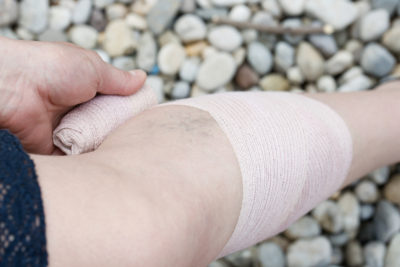 A common wound that demands quality care to prevent future problems
A common wound that demands quality care to prevent future problems
Venous skin ulcers are shallow, open wounds that generally occur just above the ankles, that will not heal even after a few weeks. Caused be venous issues, ulcers are among the most common lower leg wounds.
Who gets them?
Chronic venous disease is a problem for millions of people. This disease can lead to varicose veins, which can then advance to severe skin changes and leg ulcers. The cause of these a leg ulcer is reflux in the veins known as the perforators. There may be additional biochemical factors involved, which lead to inflammation.
Risk for venous leg ulcers increases with age. Part of the reason why they are so prevalent is that they often recur. Studies show that as many as 50 percent of venous ulcers recur within ten years.
What do they look like?
Venous leg ulcers are shallow, open wounds that are generally red in color. The shape will be round but irregular, and can vary in diameter. Sometimes a yellow film covers the wound. There is commonly a high amount of discharge from the wound.
The surrounding skin is almost always affected. Cellulitis, dermatitis, dry skin, itchiness and swelling are common. The skin will also change in color and texture.
Skin ulcers can drastically affect one’s quality of life, because of pain and because they don’t heal very quickly unless properly cared for. There may be extremity pain, burning, aching, throbbing, cramps, heaviness, itching, tiredness, fatigue and restless legs.
Common symptoms that accompany venous leg ulcers include:
Itchy, scaly, dry skin on the legs
Hardened skin around the ulcer
Heavy feeling in the legs
Red, purple, or brown color on the skin
Swollen and enlarged veins on the legs
Cracked or dry skin that may open up
Swollen ankles
Unpleasant and foul-smelling discharge from the ulcer
These symptoms collectively contribute to the significant discomfort and complications that individuals with leg ulcers face. By understanding and identifying these symptoms early, proper care and treatment can be sought to improve healing and enhance quality of life.
A few techniques are common when treating skin ulcers:
- Remove damaged, infected tissue and dead cells.
- Rest and elevation
- Compression
- The most important treatment is to close the cause of the ulcer- a perforator vein! 67% of all diabetic amputations occur form venous disease!
Compression is an important step that helps control swelling, may help protect the skin, and improves venous return.
Recurrence
Many studies show a very large recurrence rate for venous skin ulcers. Proper care of an ulcer is important to reduce the risk of recurrence, which also reduces the risk of added financial burdens to you, the patient. Closure of the venous perforator decreases recurrence to less than 15%
